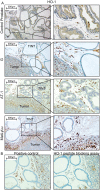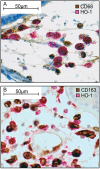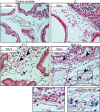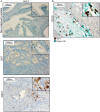Extratumoral Heme Oxygenase-1 (HO-1) Expressing Macrophages Likely Promote Primary and Metastatic Prostate Tumor Growth
- PMID: 27280718
- PMCID: PMC4900522
- DOI: 10.1371/journal.pone.0157280
Extratumoral Heme Oxygenase-1 (HO-1) Expressing Macrophages Likely Promote Primary and Metastatic Prostate Tumor Growth
Abstract
Aggressive tumors induce tumor-supporting changes in the benign parts of the prostate. One factor that has increased expression outside prostate tumors is hemoxygenase-1 (HO-1). To investigate HO-1 expression in more detail, we analyzed samples of tumor tissue and peritumoral normal prostate tissue from rats carrying cancers with different metastatic capacity, and human prostate cancer tissue samples from primary tumors and bone metastases. In rat prostate tumor samples, immunohistochemistry and quantitative RT-PCR showed that the main site of HO-1 synthesis was HO-1+ macrophages that accumulated in the tumor-bearing organ, and at the tumor-invasive front. Small metastatic tumors were considerably more effective in attracting HO-1+ macrophages than larger non-metastatic ones. In clinical samples, accumulation of HO-1+ macrophages was seen at the tumor invasive front, almost exclusively in high-grade tumors, and it correlated with the presence of bone metastases. HO-1+ macrophages, located at the tumor invasive front, were more abundant in bone metastases than in primary tumors. HO-1 expression in bone metastases was variable, and positively correlated with the expression of macrophage markers but negatively correlated with androgen receptor expression, suggesting that elevated HO-1 could be a marker for a subgroup of bone metastases. Together with another recent observation showing that selective knockout of HO-1 in macrophages reduced prostate tumor growth and metastatic capacity in animals, the results of this study suggest that extratumoral HO-1+ macrophages may have an important role in prostate cancer.
Conflict of interest statement
Figures







Similar articles
-
Heme oxygenase-1 in macrophages controls prostate cancer progression.Oncotarget. 2015 Oct 20;6(32):33675-88. doi: 10.18632/oncotarget.5284. Oncotarget. 2015. PMID: 26418896 Free PMC article.
-
Critical role of endogenous heme oxygenase 1 as a tuner of the invasive potential of prostate cancer cells.Mol Cancer Res. 2009 Nov;7(11):1745-55. doi: 10.1158/1541-7786.MCR-08-0325. Epub 2009 Nov 10. Mol Cancer Res. 2009. PMID: 19903769
-
Heme oxygenase (HO)-1 expressing macrophages/microglial cells accumulate during oligodendroglioma progression.Brain Res. 2000 Nov 3;882(1-2):1-8. doi: 10.1016/s0006-8993(00)02594-4. Brain Res. 2000. PMID: 11056178
-
A novel experimental heme oxygenase-1-targeted therapy for hormone-refractory prostate cancer.Cancer Res. 2009 Oct 15;69(20):8017-24. doi: 10.1158/0008-5472.CAN-09-0419. Epub 2009 Oct 6. Cancer Res. 2009. PMID: 19808972
-
Heme Oxygenase-1 and Prostate Cancer: Function, Regulation, and Implication in Cancer Therapy.Int J Mol Sci. 2024 Aug 24;25(17):9195. doi: 10.3390/ijms25179195. Int J Mol Sci. 2024. PMID: 39273143 Free PMC article. Review.
Cited by
-
High Monocyte Count and Expression of S100A9 and S100A12 in Peripheral Blood Mononuclear Cells Are Associated with Poor Outcome in Patients with Metastatic Prostate Cancer.Cancers (Basel). 2021 May 17;13(10):2424. doi: 10.3390/cancers13102424. Cancers (Basel). 2021. PMID: 34067757 Free PMC article.
-
Heme oxygenase-1 induction mediates chemoresistance of breast cancer cells to pharmorubicin by promoting autophagy via PI3K/Akt pathway.J Cell Mol Med. 2018 Nov;22(11):5311-5321. doi: 10.1111/jcmm.13800. Epub 2018 Sep 14. J Cell Mol Med. 2018. PMID: 30216645 Free PMC article.
-
Aggressive rat prostate tumors reprogram the benign parts of the prostate and regional lymph nodes prior to metastasis.PLoS One. 2017 May 4;12(5):e0176679. doi: 10.1371/journal.pone.0176679. eCollection 2017. PLoS One. 2017. PMID: 28472073 Free PMC article.
-
Heme Oxygenase 1 Impairs Glucocorticoid Receptor Activity in Prostate Cancer.Int J Mol Sci. 2019 Feb 26;20(5):1006. doi: 10.3390/ijms20051006. Int J Mol Sci. 2019. PMID: 30813528 Free PMC article.
-
Pin-Pointing the Key Hubs in the IFN-γ Pathway Responding to SARS-CoV-2 Infection.Viruses. 2022 Sep 30;14(10):2180. doi: 10.3390/v14102180. Viruses. 2022. PMID: 36298734 Free PMC article.
References
MeSH terms
Substances
LinkOut - more resources
Full Text Sources
Other Literature Sources
Medical

